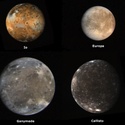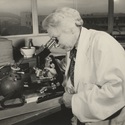In November 2014, the European Space Agency (ESA) Rosetta Mission landed a space probe called Philae onto the surface of Comet 67P, while Rosetta continued to orbit the comet. The touchdown was the result of decades of work and billions of dollars. This was a spectacular achievement in space exploration history – the first ever attempt to orbit and land on a comet had been successful!
But what exactly is a comet, and why all the effort to land on one?
What is a comet?
Scientists understand that comets are the left-overs or remnants from the formation of our Solar System. Comets existed before our Sun and before the planets in our Solar System were formed. This makes comets time capsules that consist of the original pre-solar and pre-planetary material that formed the Solar System more than 4.6 billion years ago.
The inside of a comet consists mostly of ice and dust and may have a small rocky core. If you look closely at images of comets, the ‘rocks’ you see are actually frozen chunks of gas – frozen carbon dioxide, frozen carbon monoxide, frozen nitrous oxide and frozen methane. Other important components of comets include frozen water and a rich assortment of organic (carbon-based) molecules. These are thought to include different amino acids, which may have become the source material for the primordial chemistry that formed life on Earth.
Comets are natural satellites of the Solar System and are classified according to the length of their orbit around the Sun. Short-period or periodic comets need roughly 200 years or less to complete one orbit. Long-period comets take more than 200 years. The famous Halley’s Comet (or Comet Halley) has a periodic orbit that takes 76 years – meaning that, every 76 years, we can see the comet as it passes by the Sun. There are records of Comet Halley sightings on Earth that date back almost 1000 years to 1066.
When a comet comes close to the Sun, the ice starts to melt, causing what we know as the tail of a comet. This tail – or coma – is the visible sign of gases being released from their frozen state. Sometimes the tail is seen as a fuzzy glow or atmosphere around the comet.
Most comets are found at the outer reaches of our Solar System. Many are outside the orbit of Pluto in a place called the Kuiper belt. Much further out there’s a sphere called the Oort cloud, which is 100,000 times further than the Earth is to our Sun – or 100,000 astronomical units (AU) as astrophysicists say. Within the Oort cloud sphere are billions and billions and billions of comets.
What we already knew
Before the Rosetta Mission, what we knew about comets came from probes sent out to capture images and analyse comets. In 1986, the ESA probe Giotto came within 600 km of Comet Halley and sent back detailed images and data showing, among other things, that comets contain complex organic molecules. In July 2005, the NASA project Deep Impact intentionally smashed an Impactor probe into Comet Tempel 1 to study what it was made of.
Other information about comets has come from remnants left on Earth. For example, the Murchison meteorite fell to Earth in 1969 and landed near the small town of Murchison in Australia. It started as a fireball and a loud bang in the sky over Murchison. The fireball disappeared, and moments later, tremors were felt in the area as fragments of the meteorite were showered over a 13 km radius.
Scientists collected these fragments and tested them. The chemistry results showed many organic compounds that are components of life on Earth – as well as 80 amino acids that are not found on Earth.
Murchison is thought to be the remnant core of an evaporated comet (possibly Comet Finlay) that has lost its volatile components and then crashed to Earth.
Why catch a comet?
What we know so far is that comets are the oldest and most primitive bodies within our Solar System. Scientists think that comets may hold secrets to the origin of life on Earth.
Astrophysicists believe that the Earth’s water came from comets and asteroids that heavily bombarded the young Earth 4 billion years ago. Other researchers have cast doubt on this theory. Some claim that the detection of organic molecules in significant quantities in comets might mean that comets or meteorites may have brought the precursors of life to Earth.
More missions are required to explore different comets to determine if they share similar compositions or if there are different materials found deeper within comets that were produced at the time of the Solar System’s formation.
The origins of life
As humans, we are infinitely curious about how we came into being. How did life on Earth begin? Scientists from many different disciplines are also intrigued by this question.
Explore some of the research and ideas about the origins of our Solar System and of life on Earth using these resources below.
Universal element formation
Water origins
Why Comet 67P?
Comets are an extraordinary distance from Earth, travelling at speeds of up to 42 kilometres a second.
The Rosetta Mission originally investigated a number of different comets to land on. They needed a comet that would be available when they wanted to launch Rosetta but also one they could reach in terms of distance and speed.
Comet 67P was eventually selected. Also known as Comet 67P/Churyumov-Gerasimenko after the people who discovered it, it is relatively small comet – only about 4 kilometres in diameter – and moving at a speed of 135,000 kilometres per hour. It orbits the Sun once every 6.45 years. This makes it a periodic comet.
This short orbit meant the orbit and return dates of Comet 67P could be predicted with great accuracy. This enabled the ESA to plan the Rosetta Mission years in advance, but there was still immense excitement when the mission was successful!
Find out more about the Rosetta mission in our article, To catch a comet – the Rosetta Mission.
Nature of science
Our understandings of the origins of the universe and life on Earth continue to expand as new evidence comes to light.
Useful link
Explore the story of the Murchison meteorite.
Fireballs Aotearoa aims to recover freshly-fallen meteorites and to observe meteor showers in New Zealand. They are a collaboration between members of the public, schools, universities, observatories and the Royal Astronomical Society of New Zealand.






